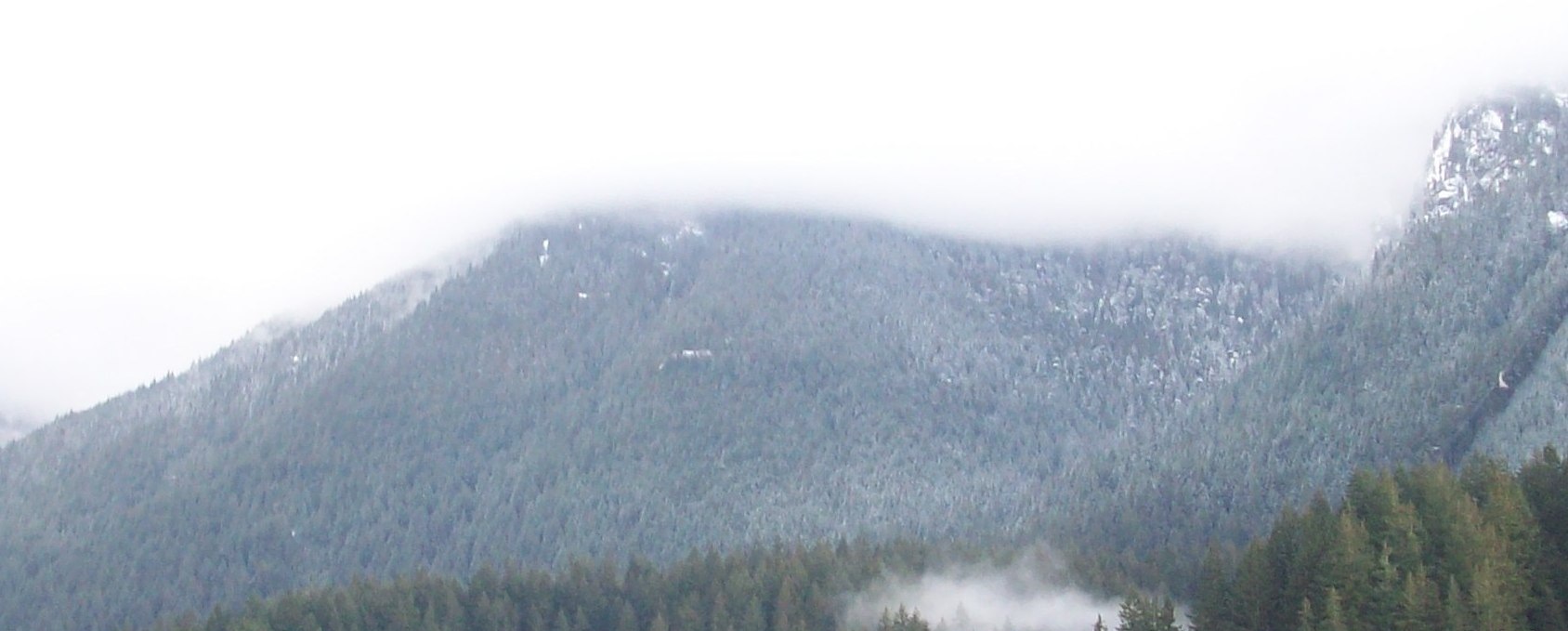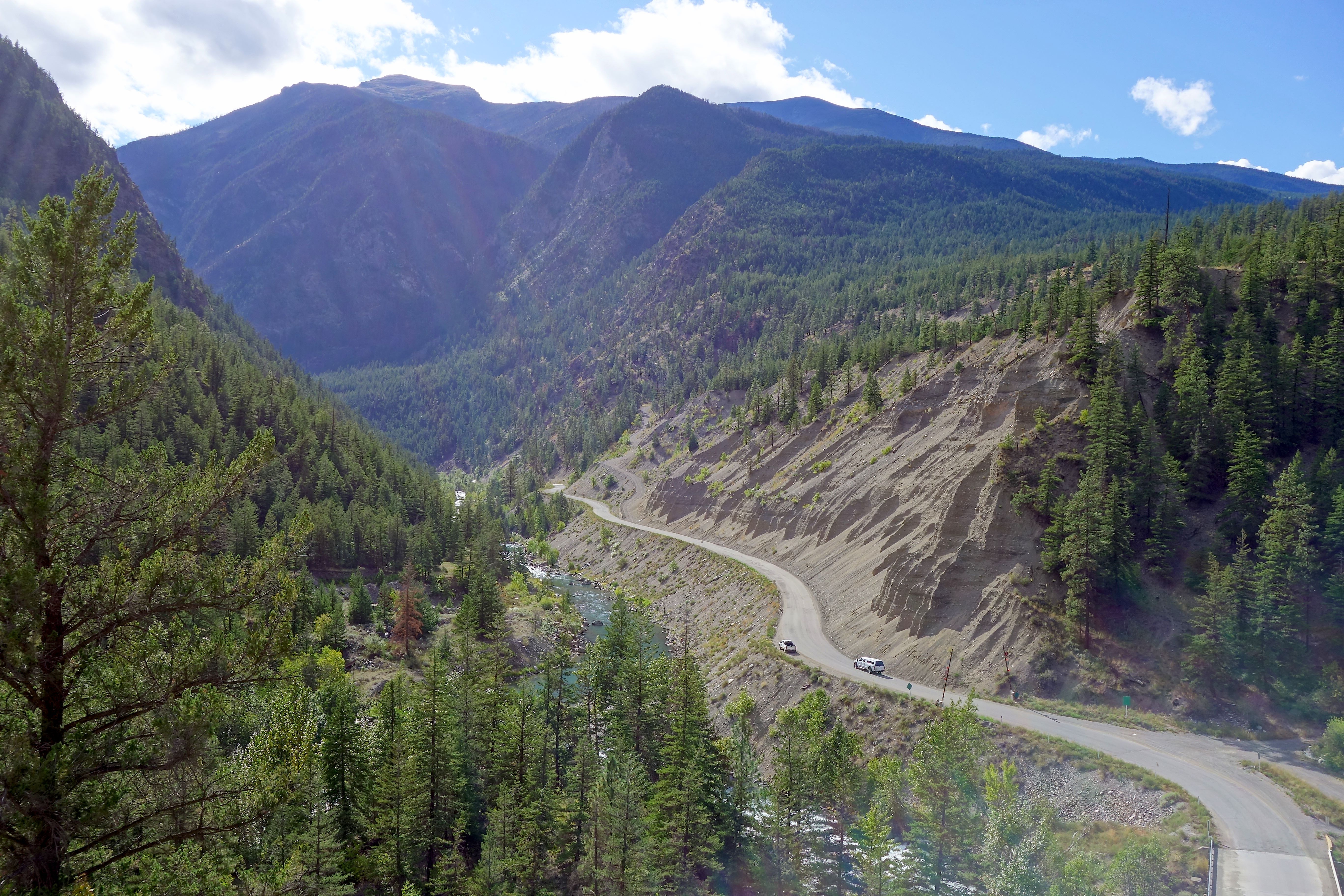|
Big Creek (British Columbia)
Big Creek is a roughly long tributary of British Columbia's Chilcotin River. Its surroundings are protected as the Big Creek Ecological Reserve. Its source is remote Lorna Lake, located deep in the midst of the Chilcotin Ranges, near the vertex of the boundaries of Big Creek Provincial Park, the valley of the Taseko River and Taseko Lakes, which lies to its west, and the Spruce Lake Protected Area to its south (aka the "South Chilcotin" even though it is in the Bridge River Country, part of the Lillooet region). Near Lorna Lake is a location known as Graveyard Valley, believed to be the site of the final battle of a 19th-century war between the Tsilhqot'in and St'at'imc peoples over control of the upper basin of the Bridge River, which lies over the mountains to the south of Big Creek. The Big Creek basin is the easternmost of three southern tributary basins of the Chilcotin, the others to its west being the Taseko River basin and, west of it, the Chilko River basin. The ... [...More Info...] [...Related Items...] OR: [Wikipedia] [Google] [Baidu] |
British Columbia
British Columbia is the westernmost Provinces and territories of Canada, province of Canada. Situated in the Pacific Northwest between the Pacific Ocean and the Rocky Mountains, the province has a diverse geography, with rugged landscapes that include rocky coastlines, sandy beaches, forests, lakes, mountains, inland deserts and grassy plains. British Columbia borders the province of Alberta to the east; the territories of Yukon and Northwest Territories to the north; the U.S. states of Washington (state), Washington, Idaho and Montana to the south, and Alaska to the northwest. With an estimated population of over 5.7million as of 2025, it is Canada's Population of Canada by province and territory, third-most populous province. The capital of British Columbia is Victoria, British Columbia, Victoria, while the province's largest city is Vancouver. Vancouver and its suburbs together make up List of census metropolitan areas and agglomerations in Canada, the third-largest metropolit ... [...More Info...] [...Related Items...] OR: [Wikipedia] [Google] [Baidu] |
Lillooet Country
The Lillooet Country, also referred to as the Lillooet District, is a region spanning from the central Fraser Canyon town of Lillooet west to the valley of the Lillooet River, and including the valleys in between, in the Southern Interior of British Columbia. Like other historical BC regions, it is sometimes referred to simply as The Lillooet or even Lillooet, (i.e. without meaning the town of the same name). The meaning of the name has changed since over time. During the gold rush and into the later 19th Century, the term Lillooet District was synonymous with the Lillooet Mining District and also the Lillooet Land District, which spanned east of the Fraser all the way to the North Thompson River. As development of that region proceeded the sense of "Lillooet District" for that area was abandoned, except in terms of reference to the Land District or the similarly shaped electoral district. The original Lillooet Country, or "Old Lillooet", lies in the valley of the Lillooe ... [...More Info...] [...Related Items...] OR: [Wikipedia] [Google] [Baidu] |
Coast Mountains
The Coast Mountains () are a major mountain range in the Pacific Coast Ranges of western North America, extending from southwestern Yukon through the Alaska Panhandle and virtually all of the British Columbia Coast, Coast of British Columbia south to the Fraser River. The mountain range's name derives from its proximity to the sea coast, and it is often referred to as the Coast Range. The range includes volcanic and non-volcanic mountains and the extensive ice fields of the Pacific Ranges, Pacific and Boundary Ranges, and the northern end of the volcano, volcanic system known as the Cascade Volcanoes. The Coast Mountains are part of a larger mountain system called the Pacific Coast Ranges or the Pacific Mountain System, which includes the Cascade Range, the Insular Mountains, the Olympic Mountains, the Oregon Coast Range, the California Coast Ranges, the Saint Elias Mountains and the Chugach Mountains. The Coast Mountains are also part of the American Cordilleraa Spanish term for ... [...More Info...] [...Related Items...] OR: [Wikipedia] [Google] [Baidu] |
Chilcotin Plateau
The Chilcotin Plateau is part of the Fraser Plateau, a major subdivision of the Interior Plateau of British Columbia. The Chilcotin Plateau is physically near-identical with the region of the same name, i.e. "the Chilcotin", which lies between the Fraser River and the southern Coast Mountains and is defined by the basin of the Chilcotin River and so includes montane areas beyond the plateau. East of the Chilcotin Plateau, across the Fraser River, is the Cariboo Plateau, while to the north beyond the West Road (Blackwater) River is the Nechako Plateau. West and south of the Chilcotin Plateau are various subdivisions of the Coast Mountains, including the Chilcotin Ranges which lie along the plateau's southwest. Included within the definition of the Chilcotin Plateau are the Rainbow Range, near Bella Coola and the similarly volcanic Ilgachuz Range and Itcha Range both of which are major shield volcanoes. The Camelsfoot Range, north of Lillooet, is included in the Chilcotin ... [...More Info...] [...Related Items...] OR: [Wikipedia] [Google] [Baidu] |
Fraser River
The Fraser River () is the longest river within British Columbia, Canada, rising at Fraser Pass near Blackrock Mountain (Canada), Blackrock Mountain in the Rocky Mountains and flowing for , into the Strait of Georgia just south of the City of Vancouver. The river's annual discharge at its mouth is or , and each year it discharges about 20 million tons of sediment into the ocean. Naming The river is named after Simon Fraser (explorer), Simon Fraser, who led an expedition in 1808 on behalf of the North West Company from the site of present-day Prince George, British Columbia, Prince George almost to the mouth of the river. The river's name in the Halqemeylem (Upriver Halkomelem) language is , often seen archaically as Staulo, and has been adopted by the Halkomelem-speaking peoples of the Lower Mainland as their collective name, . The river's name in the Dakelh language is . The Chilcotin language, ''Tsilhqot'in'' name for the river, not dissimilar to the ''Dakelh'' name, is , ... [...More Info...] [...Related Items...] OR: [Wikipedia] [Google] [Baidu] |
Churn Creek
Churn Creek is a tributary of the Fraser River in the Canadian province of British Columbia. Course Churn Creek flows generally north before turning northeast on its final leg through grasslands, joining the Fraser River just south of the headquarters of the Gang Ranch and opposite the community of Dog Creek and associated creek. Most of its lower course is a heavily-eroded canyon lined by benchlands, and is protected in Churn Creek Protected Area, which also includes the ecological preserve of the Empire Valley Ranch. Its source at approximately is at two subalpine lakes (one of which is called Horse Lake) on the northeastern shoulder of Big Dog Mountain, the northernmost major summit of the Shulaps Range, and flowing north and northwesterly until reaching the southern skirt of Poison Mountain, a northeastern outpost of the Camelsfoot Range, where it continues northwesterly, forming a divide with a small upper tributary of the Yalakom River, the main north fork of the ... [...More Info...] [...Related Items...] OR: [Wikipedia] [Google] [Baidu] |
Chilko River
The Chilko River is a river in the Chilcotin District of the Central Interior of British Columbia, Canada, flowing northeast from Chilko Lake to the Chilcotin River. Its main tributary is the Taseko River. The Chilko is the Chilcotin River's main tributary. In fact at their confluence the Chilko River is much larger than the Chilcotin. It is also the main reason why the lower reaches of the Chilcotin are very silty. The Chilko gets most of its silt from the Taseko River, which joins it a few kilometers above the Chilko's mouth. Name origin The name "Chilko" is the product of linguistic anglicisation of the Tŝilhqot’in name ''Tŝilhqóx'', (also spelled without vowel flattening as ''Tsilhqox''). The meaning of the name is contested, and is the subject of much folk etymologising. Some believe the meaning to be "ochre river", but other contenders are "axe river" (from ''tŝinlh yeqox''), "river from the ponderosa pine" (from ''tsilhtsilh yeqox''), or "river with rocks" (fro ... [...More Info...] [...Related Items...] OR: [Wikipedia] [Google] [Baidu] |
Bridge River
The Bridge River is an approximately long river in southern British Columbia. It flows south-east from the Coast Mountains. Until 1961, it was a major tributary of the Fraser River, entering that stream about six miles upstream from the town of Lillooet; its flow, however, was near-completely diverted into Seton Lake with the completion of the Bridge River Power Project, with the water now entering the Fraser just south of Lillooet as a result. The Bridge River hydroelectric complex, operated by BC Hydro, consists of three successive dams, providing water for four hydro power plants with the total rated power of total 492 megawatts. Name Its name in the Lillooet language is Xwisten (pronounced Hwist'n), sometimes spelled Nxwisten or Nxo-isten). Dubbed ''Riviere du Font'' by Simon Fraser's exploring party in 1808, it was for a while known by the English version of that name, ''Fountain River'', and some old maps show it as Shaw's River, after the name of one of Fraser ... [...More Info...] [...Related Items...] OR: [Wikipedia] [Google] [Baidu] |
Bridge River Country
The Bridge River Country is a historic geographic region and mining district in the Interior of British Columbia, Canada, lying between the Fraser Canyon and the valley of the Lillooet River, south of the Chilcotin Plateau and north of the Lillooet Ranges. "The Bridge River" can mean the Bridge River Country as opposed to the Bridge River itself, and is considered to be part of the Lillooet Country, but has a distinct history and identity within the larger region. As Lillooet is sometimes considered to be the southwest limit of the Cariboo, some efforts were made to refer to the Bridge River as the "West Cariboo" but this never caught on. Though essentially consisting of the basin of the Bridge River and its tributaries, the Bridge River Country includes the communities of D'Arcy, McGillivray Falls, Seton Portage and Shalalth, which lie in the valley of Seton and Anderson Lakes and the Gates River just to the south, are also considered to be part of the Bridge River Country, an ... [...More Info...] [...Related Items...] OR: [Wikipedia] [Google] [Baidu] |
Lillooet Land District
Lillooet Land District is one of the 59 cadastral subdivisions of British Columbia, which were created by the Lands Act of the Colony of British Columbia in 1859, defined as "a territorial division with legally defined boundaries for administrative purposes". The land district's boundaries came to be used as the boundary of the initial Lillooet riding for the provincial Legislature from 1871, when the colony became a province. In addition to use in descriptions of land titles and lot surveys, the Land District was also the basis of the Lillooet Mining District. Included in the Land District are the historical region known as the Lillooet Country, including the Pemberton Valley, and the southeast Chilcotin and South Cariboo areas. Major landforms in the land district include the Pemberton Icecap and the Lillooet Icecap. Municipalities within the land district are Pemberton, Lillooet, 100 Mile House and Clinton. Other communities include D'Arcy, Shalalth, Seton Portage, Foun ... [...More Info...] [...Related Items...] OR: [Wikipedia] [Google] [Baidu] |



